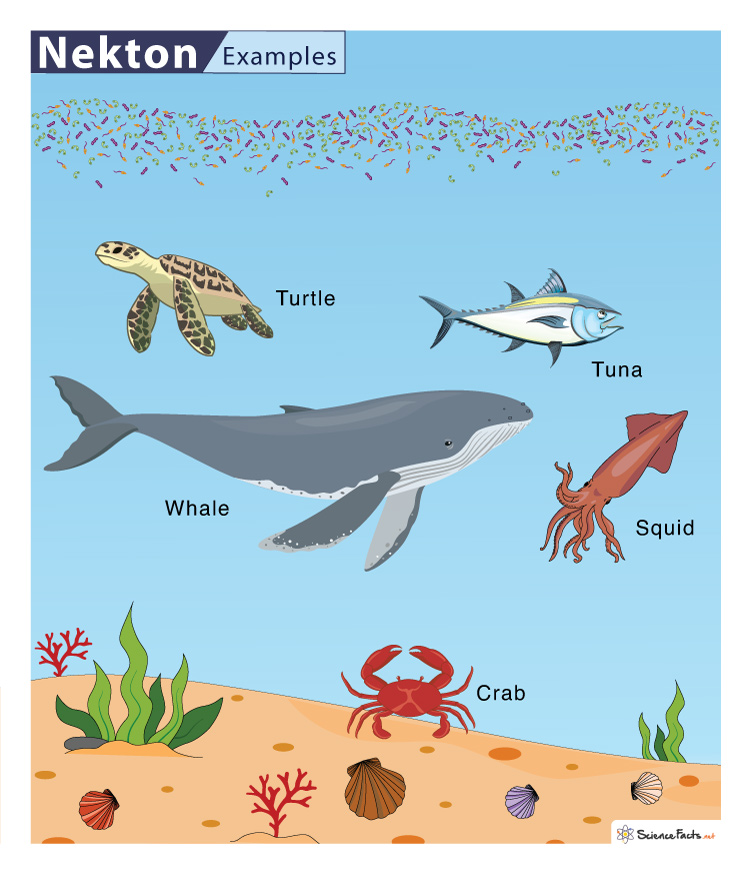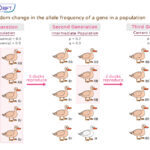Nekton
Nektons are marine organisms that can swim and move independently of moving water. Apart from some mollusks and crustaceans, most nektons are vertebrates. Some examples of nektonic organisms are whales, fish, reptiles, and birds.
They live at all depths of the ocean. Most live closer to the surface due to the presence of food. Some nektons start as planktons, those that cannot swim against the moving water currents but are considered nektons once they gain swimming ability.
The word ‘nekton’ is obtained from the Greek word ‘nekhein,’ meaning ‘to swim.’ The German biologist Ernst Haeckel first proposed and used the word’ nekton’ in 1891 to differentiate between the active swimmers in water bodies from the passive ones, the plankton.
Characteristics of Nektons
- Nektons have specialized structures to swim and float on water by regulating buoyancy experienced by their bodies.
- They are a diverse group varying in size from a few millimeters to over 30 meters long.
- Usually, pelagic live in the water column. However, some live close to the floor of the sea (demersal). Others live close to the ground, both in coastal and oceanic habitats.
- They are heterotrophic organisms that feed on other organisms for food. They may be herbivores, carnivores, or omnivores.
- They can swim a great distance in search of food. Some species swim with short bursts of speed, allowing them to catch the fast-moving prey and evade their predators.
- They maintain osmotic regulation of their bodies by keeping an isotonic environment to the seawater. They also have impermeable skin, pass less urine to conserve water, and drink seawater.
- They move by S-shaped contractions (undulations throughout the body). Their speed depends on muscle contraction, undulating fin movement, paddling motion of forelimbs, hind limbs, or both, and jet propulsion using water.
- Reproduce by producing eggs. Birds and turtles produce shelled eggs on land. Holonektonic bony fish (tuna and marlin) spawn eggs that float and undergo development in the ocean. Pelagic sharks produce only a few large eggs that females retain for an extended period.
- Migrate several distances in search of food and for mating during seasons. However, they are restricted by factors like food availability, differences in water pressure with depth, changes in salinity, and temperature variations with latitude and depth.
Types of Nektons
The adult form of nektons represents only three phyla. They are:
- Chordates that include cartilaginous fishes such as sharks, several species of reptiles (turtles, snakes, and saltwater crocodiles), and mammals such as whales and seals
- Mollusks that include squids and octopods
- Arthropods, including shrimps, crabs, and lobsters
However, Nektons are more easily classified into two broader groups: vertebrates and invertebrates.
Vertebrates
Most nektons, like fish, reptiles, and mammals, fall under this group. They have bones and cartilage in their bodies.
- Fish: It includes bony fishes like mackerel and tuna and cartilaginous fish like sharks. Such fishes have powerful tail fins, called caudal fins, that allow them to swim against ocean currents. Pectoral fins on their sides help them steer and maintain their orientation. Some fishes have a gas bladder that helps them to maintain buoyancy.
- Reptiles: These include sea turtles and sea snakes. They use their lungs for breathing air during respiration. Sea turtles use their paddle-shaped limbs, which act as fins for swimming and diving. In contrast, sea snakes have flattened tails that function as paddles.
- Mammals: Most mammals live exclusively in water, such as whales, dolphins, porpoises, seals, sea lions, walruses, manatees, and sea otters. However, some animals like sea lions, walruses, and sea otters also spend some time on land. They have streamlined bodies that help them swim high speed in the water.
- Birds: Birds such as penguins have bones with air channels. They can trap air under the feathers, which helps them in their flight.
Invertebrates
It is a relatively minor group compared to vertebrates. Invertebrates consist of:
- Crustaceans: Lobsters and crabs that feed on phytoplankton and form the primary consumer level of the marine food chain
- Mollusks: Squids and Scallops
FAQs
Ans. The main difference is that nektons can swim independently of ocean currents. In contrast, benthos cannot swim in the water and are found to remain attached to the ocean floor.
Ans. Moon jellyfish are partially plankton and partially nekton.
-
References
Article was last reviewed on Friday, February 17, 2023






